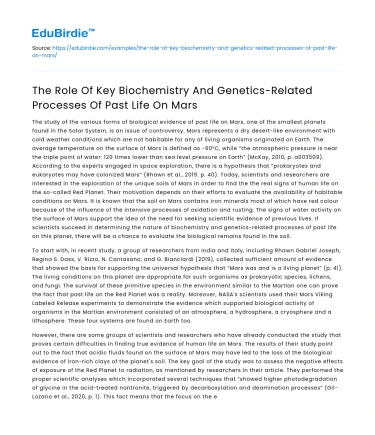The study of the various forms of biological evidence of past life on Mars, one of the smallest planets found in the Solar System, is an issue of controversy. Mars represents a dry desert-like environment with cold weather conditions which are not habitable for any of living organisms originated on Earth. The average temperature on the surface of Mars is defined as −60°C, while “the atmospheric pressure is near the triple point of water: 120 times lower than sea level pressure on Earth” (McKay, 2010, p. a003509). According to the experts engaged in space exploration, there is a hypothesis that “prokaryotes and eukaryotes may have colonized Mars” (Rhawn et al., 2019. p. 40). Today, scientists and researchers are interested in the exploration of the unique soils of Mars in order to find the the real signs of human life on the so-called Red Planet. Their motivation depends on their efforts to evaluate the availability of habitable conditions on Mars. It is known that the soil on Mars contains iron minerals most of which have red colour because of the influence of the intensive processes of oxidation and rusting. The signs of water activity on the surface of Mars support the idea of the need for seeking scientific evidence of previous lives. If scientists succeed in determining the nature of biochemistry and genetics-related processes of past life on this planet, there will be a chance to evaluate the biological remains found in the soil.
To start with, in recent study, a group of researchers from India and Italy, including Rhawn Gabriel Joseph, Regina S. Dass, V. Rizzo, N. Cantasano, and G. Bianciardi (2019), collected sufficient amount of evidence that showed the basis for supporting the universal hypothesis that “Mars was and is a living planet” (p. 41). The living conditions on this planet are appropriate for such organisms as prokaryotic species, lichens, and fungi. The survival of these primitive species in the environment similar to the Martian one can prove the fact that past life on the Red Planet was a reality. Moreover, NASA's scientists used their Mars Viking Labeled Release experiments to demonstrate the evidence which supported biological activity of organisms in the Martian environment consisted of an atmosphere, a hydrosphere, a cryosphere and a lithosphere. These four systems are found on Earth too.
However, there are some groups of scientists and researchers who have already conducted the study that proves certain difficulties in finding true evidence of human life on Mars. The results of their study point out to the fact that acidic fluids found on the surface of Mars may have led to the loss of the biological evidence of iron-rich clays of the planet's soil. The key goal of the study was to assess the negative effects of exposure of the Red Planet to radiation, as mentioned by researchers in their article. They performed the proper scientific analyses which incorporated several techniques that “showed higher photodegradation of glycine in the acid-treated nontronite, triggered by decarboxylation and deamination processes” (Gil-Lozano et al., 2020, p. 1). This fact means that the focus on the experimental approach allows scientists and researchers learning more about the Martian harsh environmental conditions. The use of clay and amino acids in the scientific experiments places emphasis on the full degradation of any biological material on the Red Planet because of the negative impact of amino acids found on the surface of Mars on the clay's ability to protect biological evidence of existence of living organisms (Gil-Lozano et al., 2020). Anyway, recent observations aimed at searching for life on Mars demonstrated the usefulness of the clay surface soils found on this planet because the clay, as the natural material, can provide protection to any form of the molecular organic substance if placed inside.
Furthermore, the various forms of observations of the current environment of Mars and the species' adaptability to the possible conditions on the surface have negative outcomes in supporting another hypothesis that transferring human life from Earth to Red Planet is possible. Some groups of scientists involved in Martian exploration studies predict that many airborne microbes, fungi, lichens, and algae may have reached Mars after being “repeatedly lofted into the upper atmosphere” in order to multiply in this environment (Joseph et al., 2019, p. 43). The survival of these species can show their physical and biological abilities to overcome the multiple challenges, such as the adverse impact of violent hyperactivity, high level of acceleration of the process of ejection into open space, extremely low temperatures, and other harsh surface conditions. To put it another way, the existence of biological evidence of past life on Mars can help scientists to conduct more comprehensive research studies which are important for drawing relevant conclusions on life on Mars.
Thus, it is necessary to conclude that scientists should continue their studies aimed at identifying the key biochemistry and genetics-related processes of past life on Mars because the obtained results could help to evaluate the biological remains in the soil, as well as determine if the evidence of life on this planet was sufficient for new experiments to transfer life from Earth to the Red Planet. There is a need for considering the fact that numerous primitive species, such as microbes, bacteria, algae, fungi, and lichens, survived in the environment similar to the Martian one could multiply on Mars and bring life on this planet. However, this evidence is still vague.






 Stuck on your essay?
Stuck on your essay?

